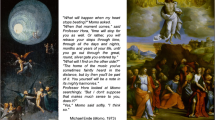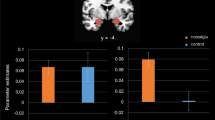Abstract
The authors present a neurobiological model for near-death experiences (NDEs) in an attempt to correlate the biological and psychological domains. This model is based on temporal lobe dysfunction, hypoxia/ischemia, stress, and neuropeptide/neurotransmitter imbalance. They describe and discuss the fundamental contribution of the language system in the construction of verbal reports of NDEs. This model could be seen as a complement to other explanatory domains.
Similar content being viewed by others
References
Abramovitch, H. (1988). An Israeli account of a near-death experience: A case study of cultural dissonance,Journal of Near-Death Studies, 6, 175–184.
Almond, P. C. (1982).Mystical experience and religious doctrine. Berlin: Mouton Publishers.
Babb, T. L. Wilson, C. L., and Isokawa-Akesson, I. (1987). Firing patterns of human limbic neurons during stereoencephalography (SEEG) and clinical temporal lobe seizures.Electroencephalography and Clinical Neurophysiology, 66, 467–482.
Brooks, S., Burrin, J., Cheetaw, M. E., Hall, G. M. Yeo, T., and Williams, C. (1988). The responses of the catecholamines and β-endorphin to brief maximal exercise in man.European Journal of Applied Physiology and Occupational Physiology, 57, 230–234.
Caplan, R. M. (1986).Exploring the concept of mind. Iowa City, IA: University of Iowa Press.
Carr, D. B. (1981). Endorphins at the approach of death.Lancet, 1, 390.
Carr, D. B. (1982). Pathophysiology of stress-induced limbic lobe dysfunction: An hypothesis for NDEs.Anabiosis: The Journal of Near-Death Studies, 2, 75–89.
Clark, W. C., Yang, J. C., and Janal, M. N. (1984). Altered pain and visual sensitivity in humans: The effects of acute and chronic stress.Annals of the New York Academy of Science, 467, 116–129.
Critchley, M. (1979).The divine banquet of the brain. New York, NY: Raven Press. pp. 1–12.
Dingledine, R., Hynes, M. A., and King, G. L. (1986). Involvement of N-methyl-D-aspartate receptors in epileptiform bursting in the rat hippocampal slice.Journal of Physiology, 380, 175–189.
Eliade, M. (1964).Shamanism: Archaic techniques of ecstasy (W. R. Trask, trans.). Princeton, NJ: Princeton University Press.
Efron, R. (1963). Temporal perception, aphasia and déjà vu.Brain, 86, 403–424.
Fagg, G. E. (1985). L-glutamate, excitatory aminoacid receptors and brain function.Trends in Neuroscience, 8, 207–210.
Frederiks, J. A. M. (1969). Disorders of the body schema. pp. 207–240 in P. J. Vinken and G. W. Bruyn (Eds.),Handbook of clinical neurology. Vol. 4: Disorders of speech, perception, and symbolic behavior. New York. NY: American Elsevier Publ. Co.
Frederiks, J. A. M. (1985). Paroxysmal neuropsychological disorders. pp. 507–514 in P. J. Vinken, G. W. Bruyn, H. I. Klawans, and J. A. M. Frederiks (Eds.),Handbook of clinical neurology, Vol. 45 (Revised series vol. 1): Clinical neuropsychology New York, NY: Elsevier Science Publ. Co.
Fujiwara, N., Higashi, H., Shimoki, K., and Yoshimura, M. (1987). Effects of hypoxia on rat hippocampal neurons in vitro.Journal of Physiology, 384, 131–151.
Gabbard, G. O., Twemlow, S. W., and Jones, F. C. (1981). Do “near-death experiences” occur only near death?Journal of Nervous and Mental Disease, 169, 374–377.
Gazzaniga, M. S. (1985).The social brain. New York, NY: Basic Books.
Gazzaniga M. S., and LeDoux, J. E. (1985).The integrated mind. New York, NY: Plenum Press.
Gellman, R., and McNamara, I. (1984). Selective depletion of norepinephrine with the neurotoxin DSP4 facilitates kindling development in rats.Society for Neuroscience, 10, 343.
Gibson, G. E., and Blaas, J. P. (1979). Proportional inhibition of acetylcholine synthesis accompanying mild hypoxia and hypoglycemia.Journal of Neurochemistry, 27, 37–42.
Glennon, R. A. (1985). Involvement of serotonin in the action of hallucinogenic drugs. In R. A. Green (Ed.),Neuropharmacology of serotonin. Oxford, England: Oxford University Press.
Gloor, P. (1982). Temporal lobe epilepsy: Its possible contributions to the understanding of the functional significance of the amygdala and of its interaction with neocorticaltemporal mechanisms. Pp. 423–457 in B. E. Eleftherion (Ed.),The neurobiology of the amygdala. New York, NY: Plenum Press.
Gloor, P., Olivier, A., Quesney, L. F., Andermann, F., and Horowitz, S. (1982). The role of the limbic system in experiential phenomena of temporal lobe epilepsy.Annals of Neurology, 12, 129–144.
Greyson, B. (1981). Toward a psychological explanation of near-death experiences: A response to Dr. Grosso's paper.Anabiosis: The Journal of Near-Death Studies, 1, 88–103.
Greyson, B. (1983a). The Near-Death Experience Scale: Construction, reliability, and validity.Journal of Nervous and Mental Disease, 171, 369–375.
Greyson, B. (1983b). The psychodynamics of near-death experiences.Journal of Nervous and Mental Disease, 171, 376–381.
Greyson, B. (1985). A typology of near-death experiences.American Journal of Psychiatry, 142, 967–969.
Greyson, B., and Stevenson, I. (1980). The phenomenology of near-death experiences.American Journal of Psychiatry, 137, 1193–1196.
Grosso, M. (1981). Toward an explanation of near-death phenomena.Anabiosis: The Journal of Near-Death Studies, 1, 3–26.
Gupta, A. R., Jeavons, P. M., Hughes, R. C., and Covanis, A. (1983). Aura in temporal lobe epilepsy: Clinical and electroencephalographic correlations.Journal of Neurology, Neurosurgery, and Psychiatry, 46, 1079–1083.
Halgren, E., Walter, R. D., Cherlow, D. G., and Crandall, P. H. (1978). Mental phenomena evoked by electrical stimulation of the human hippocampal formation and amygdala.Brain, 101, 83–117.
Halgren, E., and Wilson, C. L. (1985). Recall deficits produced by afterdischarges in the human hippocampal formation and amygdala.Electroencephalography and clinical Neurophysiology, 61, 375–380.
Hausser-Hauw, C., and Bancaud, J. (1987). Gustatory hallucinations in epileptic seizures.Brain, 110, 339–359.
Henriksen, S. J., Bloom, F. E., McCoy, F., Ling, N., and Guillemin, R. (1978). β-endorphin induces non-convulsive limbic seizures.Proceedings of the National Academy of Sciences, 75, 5221–5225.
Hiller, J. M., Itzhak, Y., and Simon, E. J. (1986). Limbic regions of the brain of Alzheimer's disease patients show selective changes in mu, delta and kappa opioid receptor binding.NIDA Research Monographs, 75, 559–562.
Hong, C. H., Woo, J. I., Suh, Y. H., Park, C. W., and Lee, C. K. (1987). Effect of ketamine on the acetylcholine concentration of various regions of rat brain.Seoul Journal of Medicine, 28, 347–351.
Isaacson, R. L. (1982).The limbic system. New York, NY: Plenum Press.
James, W. (1890).Principles of psychology. New York, NY: Holt.
Janz, D. (1986). Epilepsy, viewed metaphysically: An interpretation of the Biblical story of the epileptic boy and of Raphael's Transfiguration.Epilepsia, 27, 316–322.
Kelly, D. D. (1982). The role of endorphins in stress-induced analgesia.Annals of the New York Academy of Science, 398, 260–271.
Judson, I. R., and Wiltshaw, E. (1983). A near-death experience.Lancet, 2, 561–562.
Kissin, B. (1986).Conscious and unconscious programs in the brain. New York, NY: Plenum Press.
Kroll, J., and Bachrach, B. (1982). Visions and psychopathology in the Middle Ages.Journal of Nervous and Mental Disease, 170, 41–49.
Landsborough, D. (1987). St. Paul and temporal lobe epilepsy.Journal of Neurology, Neurosurgery, and Psychiatry, 50, 659–664.
Leitner, D. S. (1984). Alteration in other sensory modalities accompanying stress analgesia as measured by startle reflex modification.Annals of the New York Academy of Science, 467, 82–92.
Lukianowicz, N. (1958). Autoscopic phenomena,Archives of Neurology, 80, 199–220.
Masters, R. E. L., and Houston, J. (1967).The varieties of psychedelic experience. New York, NY: Dell.
McGinty, J. F., Kanamatsu, T., Obie, J., and Hong, J. S. (1986). Modulation of opioid peptide metabolism by seizures: differentiation of opioid subclasses.NIDA Research Monographs, 71, 89–101.
McIntosh, T. K., Fernyak, S., and Faden, A. I. (1986). Endogenous peptides, opiate receptors and traumatic brain injury.NIDA Research Monographs, 75, 527–530.
Mclean, S., Rothman, R. B., and Herkenham, M. (1986). Autoradiographic localization of μ-and δ-opioid receptors in the forebrain of the rat.Brain Research, 378, 49–60.
Mesulam, M. M. (1981). Dissociative states with abnormal temporal lobe EEG.Archives of Neurology, 38, 176–181.
Mesulam, M., and Appenzeller, T. (1987). The anatomy of memory.Scientific American, 256, 62–71.
Modai, I., and Cygielman, G. (1986). Conversion hallucinations: A possible mental mechanism.Psychopathology, 19, 324–326.
Naranjo, C. (1973). Psychological aspects of the Yagé experience in an experimental setting. In M. J. Harner (Ed.),Hallucinations and shamanism. London, England: Oxford University Press.
Neumaier, J. F., Mailheau, S., and Chavkin, C. (1988). Opioid receptor-mediated responses in the dentate gyrus and CA1 regions of the rat hippocampus.Journal of Pharmacology and Experimental Therapeutics, 244, 564–570.
Pardes, H. (1980). Neuroscience and psychiatry: Marriage or coexistence?American Journal of Psychiatry, 143, 1205–1212.
Pasricha, S., and Stevenson, I. (1986). Near-death experiences in India.Journal of Nervous and Mental Disease, 174, 165–170.
Penfield, W. (1955). The role of the temporal cortex in certain psychical phenomena.Journal of Mental Science, 101, 451–465.
Plum F., and Pulsinelly, W. A. (1986). Cerebral metabolism and hypoxic-ischemic brain injury. pp. 1086–1100 in A. K. Asbury, G. M. McKhann, and W. I. McDonald (Eds.),Diseases of the nervous system, Vol. 2. Philadelphia, PA: Ardmore Medical Books.
Ravagnati, L., Halgren, E., Babb, T. L., and Crandall, P. H. (1977). Activity of human hippocampal formation and amygdala neurons during sleep.Neuroscience Abstracts, 3, 471.
Rayport, M., and Ferguson, S. M. (1974). Qualitative modifications of sensory responses to amygdaloid stimulation in man by interview content and context.Electroencephalography and Clinical Neurophysiology, 34, 714.
Ring, K. (1980).Life at death: A scientific investigation of the near-death experience. New York, NY: Coward, McCann and Geoghegan.
Rogo, D. S. (1984). Ketamine and the NDE.Anabiosis: The Journal of Near-Death Studies, 4, 87–96.
Saavedra-Aguilar, J. C. and Gómez-Jeria, J. S. (1987). Towards a neurobiological model of self-consciousness.Revista Chilena de Neuro-Psiquiatria, 25, 247–251.
Sabom, M. S. (1982).Recollections of death: A medical investigation. New York, NY: Harper and Row.
Sabom, M. S., and Kreutziger, S. (1977a). The experience of near-death.Death Education, 1, 195–203.
Sabom, M. S., and Kreutziger, S. (1977b). Near-death experiences.New England Journal of Medicine, 297, 1071.
Saunders, R. C., and Rosene, D. L. (1988). A comparison of the afferents of the amygdala and the hippocampal formation in the Rhesus monkey. I: Convergence in the entorhinal, prorhinal and perirhinal cortices.Journal of Comparative Neurology, 271, 153–184.
Saunders, R. C., Rosene, D. L., and Van Hoesen, G. W. (1988). Comparison of the efferents of the amygdala and the hippocampal formation in the Rhesus monkey. II: Reciprocal and non-reciprocal connections.Journal of Comparative Neurology, 271, 185–207.
Schenk, L., and Bear, D. (1981). Multiple personality and related dissociative phenomena in patients with temporal lobe epilepsy.American Journal of Psychiatry, 138, 1311–1316.
Seifert, W. (1983).neurobiology of the hippocampus. New York, NY: Academic Press.
Siegel, R. (1980). The psychology of life after death.American Psychologist, 35, 911–931.
Siegel, R., and Hirschman, A. (1984). Hashish near-death experiences.Anabiosis: The Journal of Near-Death Studies, 4, 69–89.
Siesjo, B. K., and Wieloch, T. (1986). Epileptic brain damage: Pathophysiology and neurochemical pathology. pp. 813–855 in A. V. Delgado-Escueta, A. A. Ward, D. M. Woodbury, and R. J. Porter (Eds.),Advances in Neurology, Vol. 44, New York, NY: Raven Press.
Taylor, D. C., and Lochery, M. (1987). Temporal lobe epilespsy: Origin and significance of simple and complex auras.Journal of Neurology, neurosurgery, and Psychiatry, 50, 673–681.
Tobacyk, J. J., and Mitchell, T. O. (1987). The out-of-body experience and personality adjustment.Journal of Nervous and Mental Disease, 175, 367–370.
Tulving, E. (1987). Multiple memory systems and consciousness.Human Neurobiology, 6, 67–80.
Van Eeden, F. (1969). A study of dreams. pp. 145–158 in C. Tart (Ed.),Altered states of consciousness. New York, NY: John Wiley.
Webb, W. B., and Cartwright, R. D. (1978). Sleep and dreams.Annual Review of Psychology, 29, 223–252.
Wieser, H. G. (1983). Depth recorded limbic seizures and psychopathology.Neuroscience and Biobehavioral Reviews, 7, 427.
Woodbury, D. (1984). Neurotransmitters and epilepsy: Distinguishing characteristics and unifying concepts.Federation Proceedings, 43, 2529–2531.
Zimberg, N. E. (1977).Alternate states of consciousness. London, England: Free Press.
Author information
Authors and Affiliations
Rights and permissions
About this article
Cite this article
Saavedra-Aguilar, J.C., Gómez-Jeria, J.S. A neurobiological model for near-death experiences. J Near-Death Stud 7, 205–222 (1989). https://doi.org/10.1007/BF01074007
Issue Date:
DOI: https://doi.org/10.1007/BF01074007




